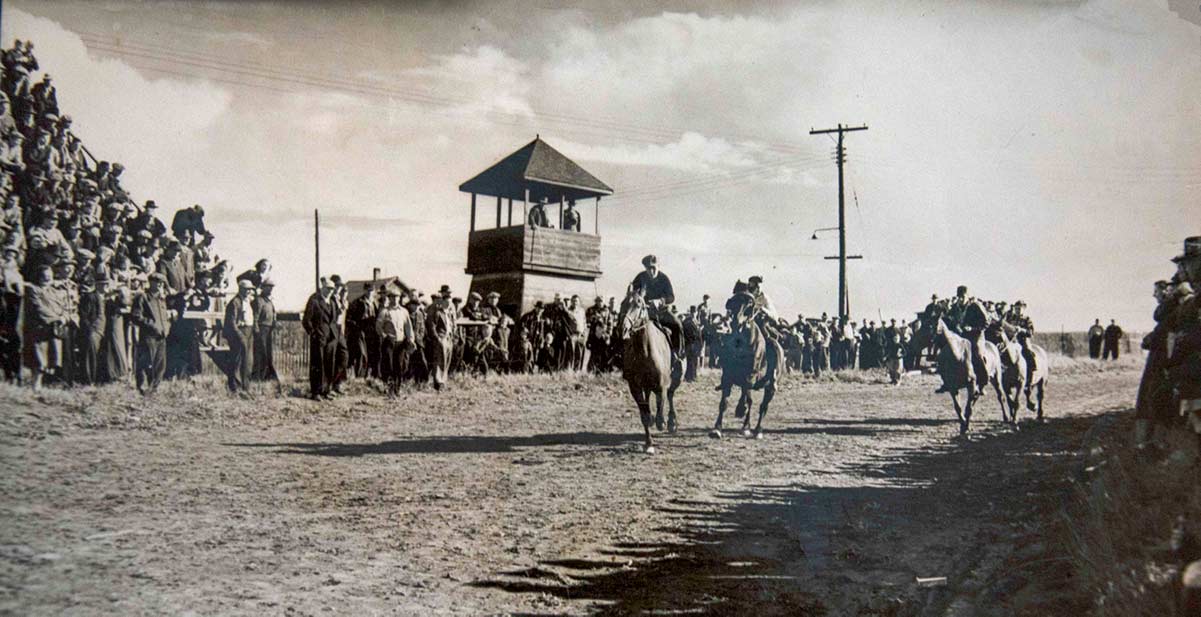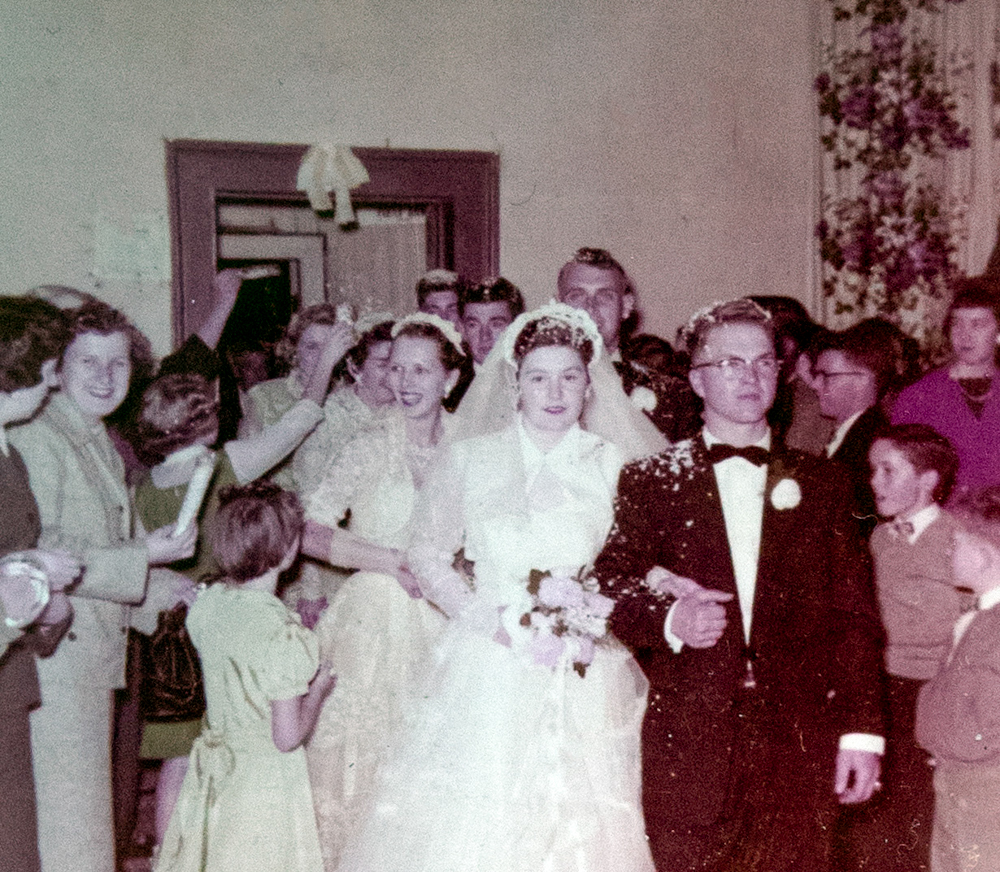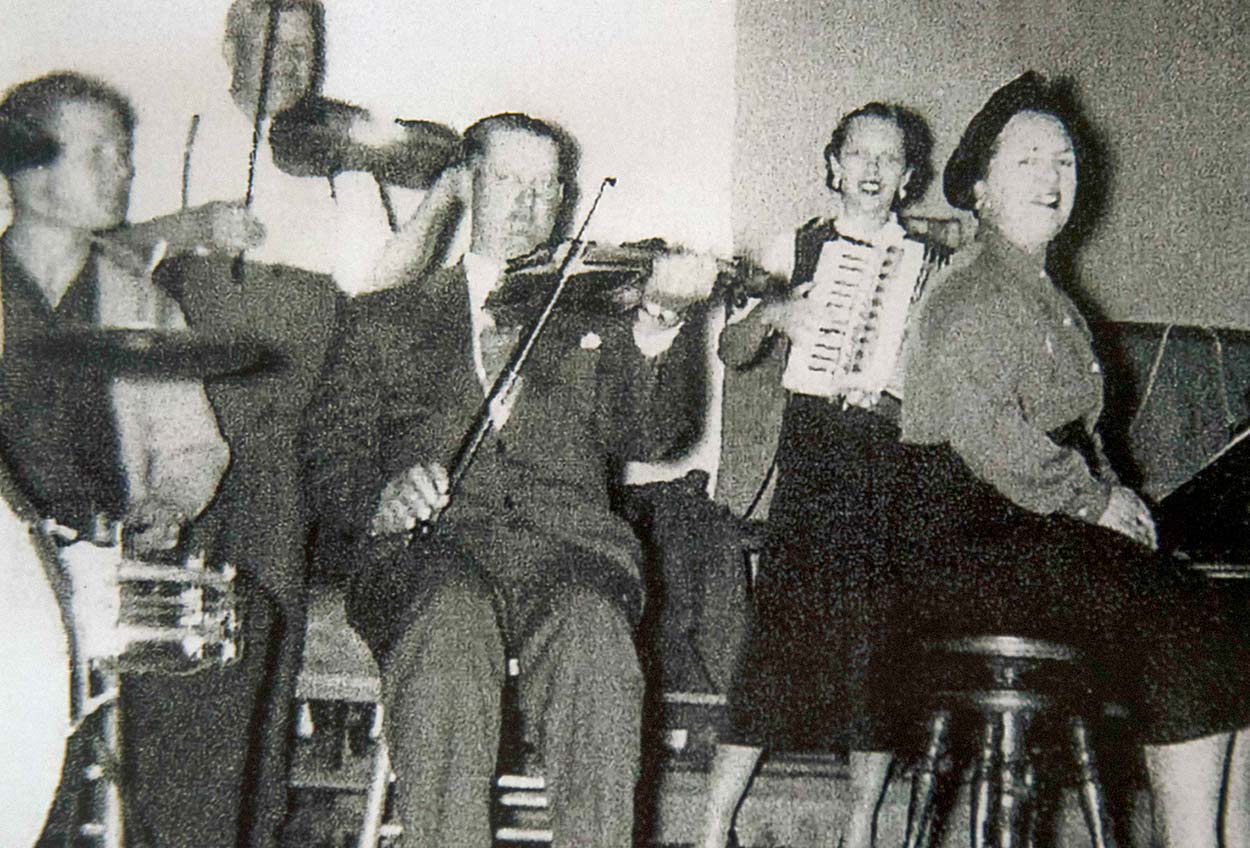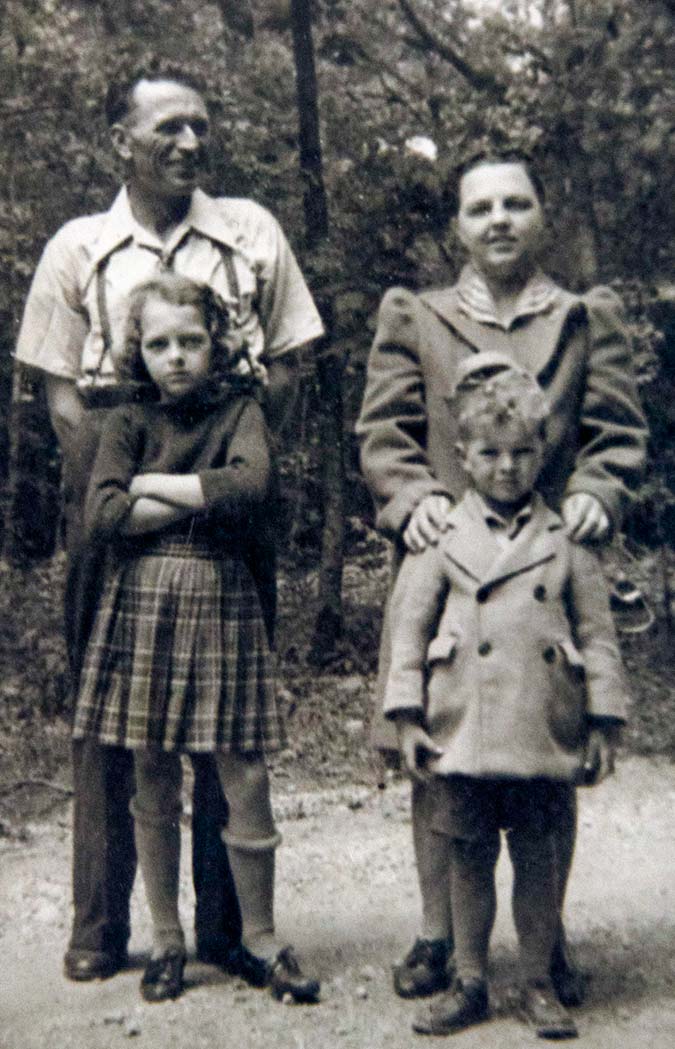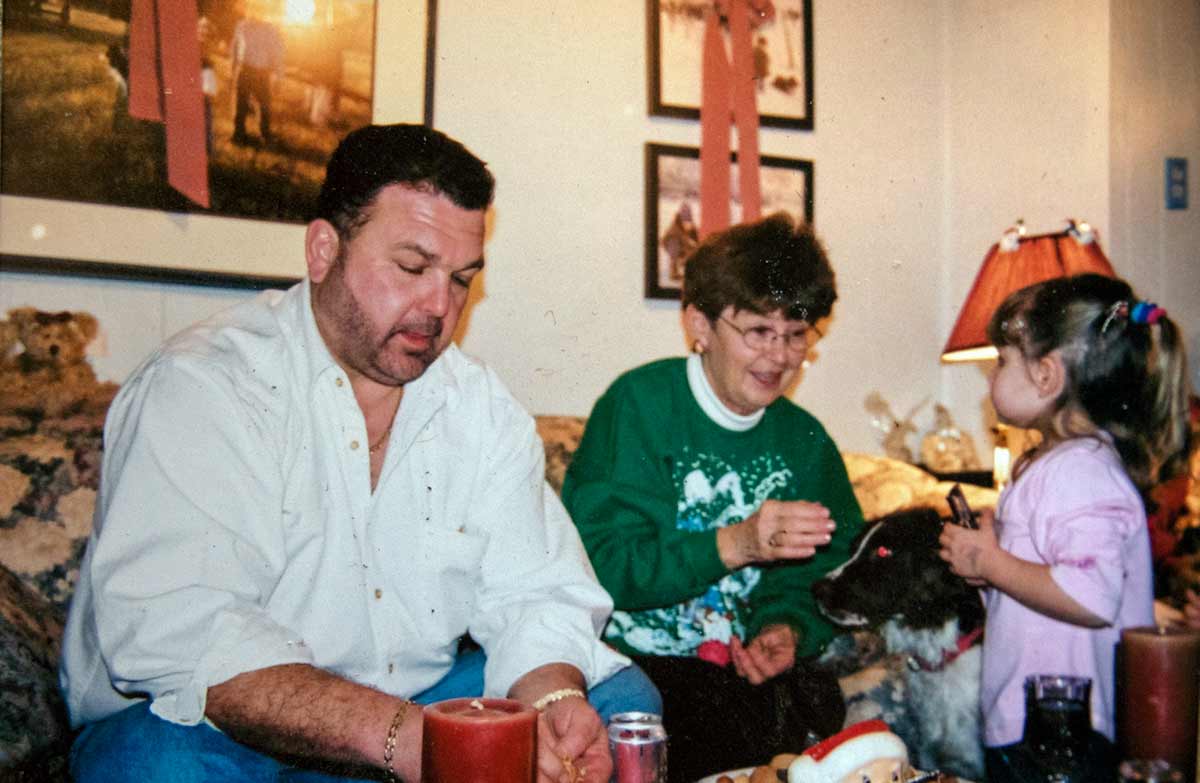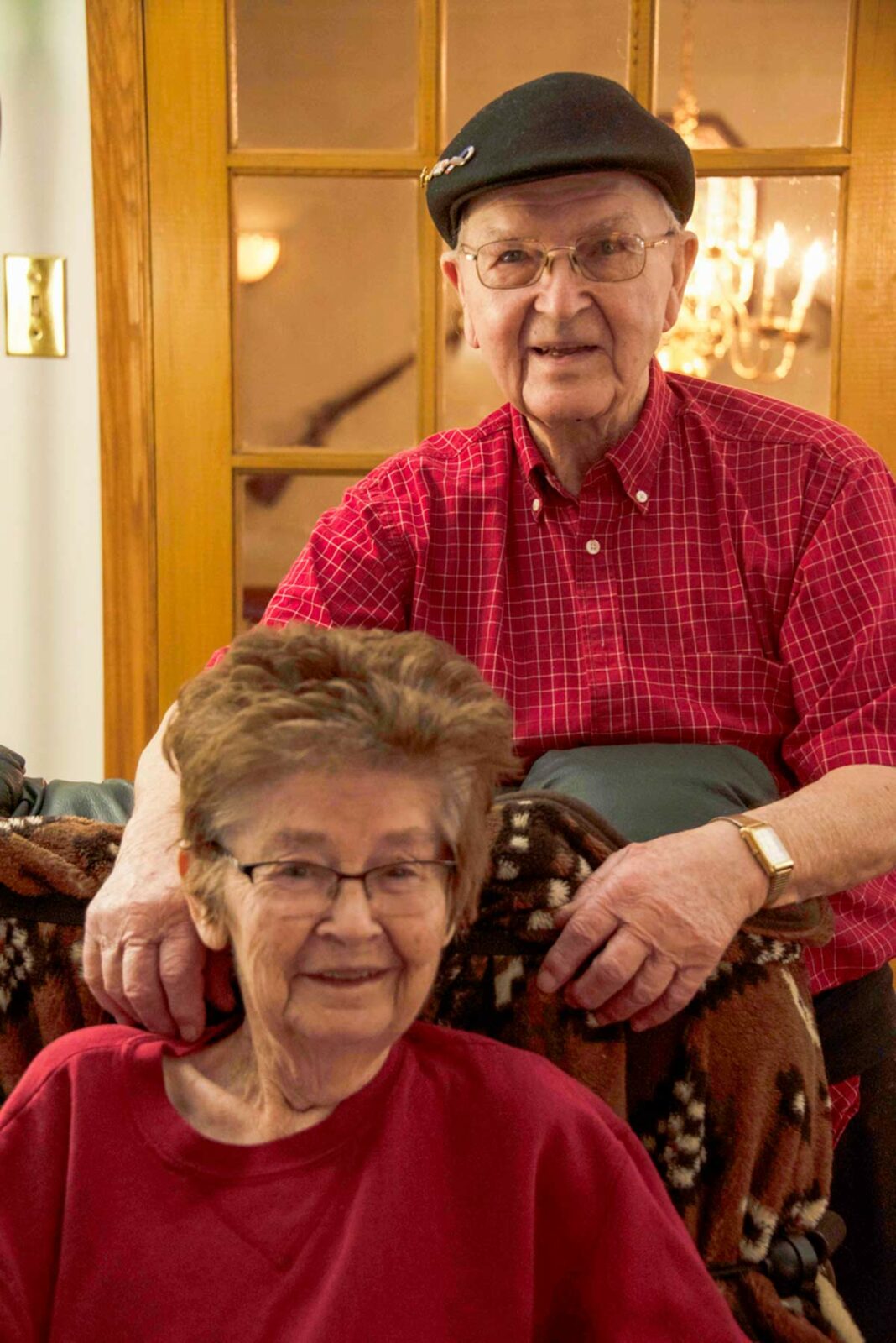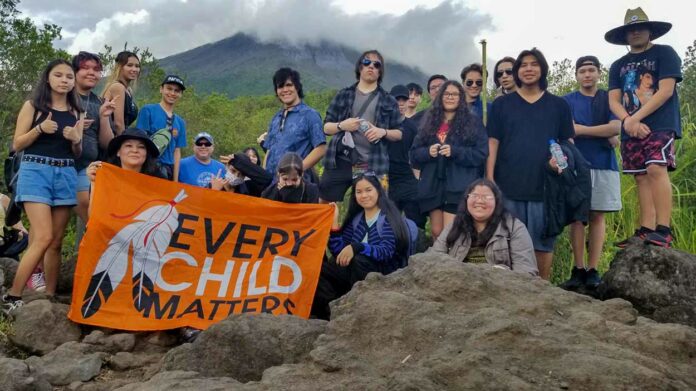by Pretra Wall
John and Rae Skippen
John Skippen is part of the fifth generation of a long line of Skippen ancestors that first came to the Green Bay area of Manitoulin to farm in 1870. He is a jovial storyteller with a keen memory and strong interest in the historical aspects of his family tree. “One of my early ancestors was a general in the English army, about the mid 1800s. My first ancestor here was my great-great grandfather, also John Skippen. He arrived from Europe in a sailing boat and settled in southern Ontario before moving to Manitoulin. He arrived at Sheguiandah in the fall of 1872 and luckily found a wigwam that the local Anishinaabe folk were using to make maple syrup. He was allowed to use it to shelter his wife Elizabeth and his family for the winter. In the spring, he came to the Lime Kiln area where the local quarry is. He found little soil there so moved the family to the nearby Green Bay Valley area and a home was built. He had a family of eight boys and four girls.”
“He was charged one dollar for 100 acres and to keep it, he had to clear enough land to support his family. The very early settlers had no horses, so trees felled with axes, were ‘trailed,’ that is pulled out of the bush by hand. John had oxen to clear the swampy areas, and he managed to clear enough to grow food and shelter a few animals. About 14 years later, John owned many farms. Each son had his own cleared land in the Green Bay Valley. Son William married Pearl Bryan of Gore Bay. William continued to farm as did his son, John Thomas who married Anna Stringer. As a side note of interest, Henry, another of William’s sons, created directions using landmarks to help new visitors get to Rockville. He added comments like, ‘pass the building where the bear tore off the front door’ or ‘go through the yard with the rail fence,’ etc. and continue until you get to Rockville.’”
“I recall a story about John Thomas’s brother Noye who had lost his leg in an accident. The leg was subsequently buried nearby. Noye insisted the leg had to be dug up and moved because he could still feel discomfort in this missing leg. The family dug up the leg and repositioned it. It seems that Noye had no discomfort after that. He plowed his field with one leg. He and his wife also dug a hole under the house for their new oil furnace. Noye, under the house, would fill a small can with dirt and pass it through a tiny opening to his wife who would toss it away. Noye also used his peg-leg once to stop a car from rolling down the hill, traumatizing a witness who thought he was using his own foot.”
When grandfather Batman died, dad was concerned his grandson, Jerry, 10, might be distressed by the burial so Jerry was asked to stay home. His grandson, a bit of an adventurer, had other plans. Nobody saw him climb into the wooden rough box which also contained the coffin. He emerged again at the graveyard. The family was surprised but decided to let him stay.” Perhaps his being present at the burial helped him understand this stage of life and offered a closing for him.
“The son of John Thomas Stringer, John ‘Ross,’ my father, covertly married his sweetheart, Isabelle Sheppard-Connor, the daughter of Harry Shepherd and Isabella Spry. Isabella had died when her daughter Isabelle was just a baby. Isabelle was raised in Sheguiandah by an aunt in the Connor-Batman family. The night John Ross married Isabelle, he climbed the ladder to her room and carefully brought her down, trying not to wake up others in the home. They got to the Lewis home and were married. After her family became familiar with John Ross, they accepted the union.”
“My sister Annabelle was their first-born. I arrived in Green Bay, on February 18, 1935.” As an adult, Annabelle later worked in the Wagg’s store and in the creamery. She married Ken Smeltzer who helped run the creamery with the owner Duff Brown. Dad Ross was on local council for Howland Township. My father also had two sisters, Gladys, and Gertie. Gladys became a nurse. Her husband worked for the Customs office in Little Current. Gertie’s husband served in two world wars. Gertie owned the Edgewater Restaurant.”
“I remember turning six. My parents told me to look in the pony manger where I found a handsome pair of red rubber boots. They were great on the farm. At that time, I was milking four cows a day and putting the milk into a separator to get cream. My father would take the sleigh and pick up cream from all the Green Bay farmers and meet the Wagg’s truck in Sheguiandah. Dad also cut a lot of wood with Uncle Noye and then cut it into boards with a belt saw.”
“My early school memories were not positive. I remember being the target of a few bullies but I did my share of mischief too. One incident could have turned out to be a tragedy. We had built an ice igloo for a jail and put a ‘prisoner’ in it. We plugged up the opening with snow to make ‘prisoner’s bars.’ We soon realized that the prisoner might be running out of air and quickly dug him back out. He was looking a little stressed by the time we reached him, but he was fine.”
“Getting the strap was a regular occurrence for me. Talking to a girl in the school basement warranted the strap. I did deserve this punishment when I threw an icy snowball at the window of the outhouse to annoy the teacher. Unfortunately, it hit him in the head. He grabbed me and bounced me all the way back to the schoolhouse. The strap he used was salvaged from a horse’s harness and gave me blisters each time. Finally, after Grade 8, I was given this weapon as a souvenir.”
Like many others, John left school at 14 and worked on the farm. “I helped with the animals and did general farm work. When the annual fair was held in Manitowaning each July, I loved being in the races. In 1950, I was 15 and my horse was the fastest that year. We won the race easily and I was standing beside my horse when the others came to the finish line.” He also recalls the horror of hearing his horse get shot, three days after the horse had twisted his foot in a hole, while running.
“My first car was a 1951 Chevy. When we were old enough to work at KVP, the pulp and paper mill in Espanola, a buddy and I decided to try our luck at getting employment there. As the car pulled out of the yard, mother ran after us. She reached us, breathless and begged us not to go. ‘You are needed on the farm,’ she insisted. We stayed home. I was also a bit of a daredevil in my earlier years. I loved to race the car over a steep rise in the road, near the Green Bay Church. It would launch eight feet into the air. I repeated this a few times, but never had an accident.”
“Music was always important to our family. Mother was a wonderful piano player. She would play the notes first, then play by ear. For 30 years she performed every Saturday night in the Spring Bay Hall. At age eight I got a dollar for playing my guitar while mother played the piano. I also learned to play the accordion and drums. I bought the drum set from Jack Seabrook. Mother played for 80 weddings but never charged; it was always a gift for the new couple. One time, the Queen of Denmark came to a dance at Spring Bay. It was during the war years and she felt safer in Canada, at a nearby lodge with her husband and two children. We showed her how to square dance and she was so happy that we played for her.”
John met Rae Moggy in the mid 1950s. Rae, born on August 10, 1938, was a middle child. “I used to play with the boys, Rae shares. “My sister Norma was five years older and had her own friends, as did my older brother Hugh. Glen and Bill were younger. Bill, seven years younger, selected me as his go-to person. When my parents went to the barn to milk the cows, I was also responsible for the dishes.”
“School was a mile and a quarter away and roads were not plowed. I always hoped a team of horses had gone by so we could walk in their tracks. Mr. James ‘Lucky’ Tilson was my teacher for the first five years and he was our son Paul’s teacher too. I liked school and spelling, but I didn’t like reading out loud. Once, I accidentally broke Mr. Dinsmore’s finger. We were playing baseball and he was on first base. I hit the ball hard and it made a beeline for his finger.”
“I recall the horses with bells jingling, heading into the woods with all of us. We were cozy under our quilts, determined to find a huge Christmas tree. They jingled again on Christmas Day, heading over to Grandma Sadie’s house four miles away. One year, at six, I got a pretty pair of white boots. They were handy for cleaning the snow off the ice rink at our neighbour’s home. That job took two hours and gave us only a short time to skate on the rink before bedtime. The next day, we often had to do it all again.”
“Summer jobs were at Lonestar Camp on Bidwell Road, run by our aunt and uncle and at the Red Lodge. I cleaned cabins and waited on tables. Ford Plant employees were frequent guests at the Lonestar Camp.” Soon Rae and John started to date. “She was beautiful, and the nicest girl in Manitowaning,” John recalls. Rae was impressed with his musical talents and how well he and his mother sounded together.
The wedding was held on October 12, 1956, in the Knox United Church in Manitowaning. The reception was staged in the Orange Hall where Doug Smith and his Gore Bay Orchestra played the music. John adds, “I recall Doug giving me a shot of vodka behind the hall to celebrate my entering this new stage in life. An old 1951 Chevy truck, found without wheels on top of a stone pile at Nobles, took us on our honeymoon. With new wheels, the truck took us to Toronto and Castlerock, Michigan. The fenders were barely hanging on.”
“Rae and I moved to the farm. Dad had sold his horse for $100 and that money built our home. We had 40 to 50 beef cattle that could be milked and used for meat. I started to drive a school bus and continued that 55-mile route for 30 years.” John also got his pilot’s and boating licences. It was handy being able to fly to destinations from the airport at Ten Mile Point. My flight instructor, Roland Hemner at the Sudbury airport, had also taught the ace who later led the Snowbirds Demonstrations Squadron of the Royal Canadian Air Force. I never had a significant accident in any vehicle.”
“My next road vehicle was a rusted truck with no top. I cut the top off my older ‘51 Chevy and welded it to the newer truck. In 1972, we also bought 200 acres at Ten Mile Point for grazing beef cattle. On our home farm, the government surveyed the land and kindly told us where the creeks were running, and how we could drain the fields. My uncle Francis Skipper, ‘Franzie,’ put up the track to lift the hay into the barn. Sadly, it accidentally fell, and Uncle Franzie was badly hurt.”
John and Rae have one son, Paul and he was taught farmwork at a young age. “After 1985, when square bales came in, I joined John and Paul, getting them on the conveyor belt, into the barn,” Rae adds. She also became a clerk at Turner’s in Little Current for three years before she became the accountant at Tim’s and Co. (now RONA Little Current Building Supply) for 21 years. Tim’s sold lumber and hardware.
“I recall Paul’s first outside job at the Sandy Beach Trailer Park near here,” John recalls, smiling. “He was selling ice cream from a truck. I had purchased the bars for resale but found out he was giving them away. A lesson was taught about successful business practices. Later, Paul became a teacher at the high school. He taught mechanics and other subjects.”
Were you named after anyone? “I was named after John Alfred Morphet. My full name is John Edwin Alfred Skipper. My fondest memory? Meeting and marrying Rae. I ran into her sister in a Manitowaning store and asked her if I could take her to the dance that night. She said ‘no, but you can take my sister. I will bring her to the Bidwell Hall.’ At the hall, mother was playing the piano. I found Rae standing with a group of girls and approached her. That was the best decision I have ever made.”
Favourite pets? “Our dogs, collies and the horses that would take us to school in the democrat. The horses would be tethered in a small barn where they got some oats and hay while they waited. My horse broke out once and ran all the way home without me.”
Favourite season? Rae: “Spring when weather is warmer, and all life is a fresh green.”
Collections? John: “Money, and watches. I have collected many different watches over the years. Rae has a wonderful collection of antique glass dishes, all different colours.”
An enjoyable trip? John continues, “the east coast of Canada. Rae, her brother Hugh and his wife Marilyn and I went, and we had a lot of fun. A police officer stopped us for speeding. We told him we were from Manitoulin, and he said, ‘You are lucky,’ I hunt there. Next time, slow down; you are in the computer now.’”
Strengths? “With one arm, as a youth, I could lift a big weight, like a barn jack, over my head. We also moved a huge rock near the door of the schoolhouse, before a Christmas concert. Also flying. I learned to fly a Pitts Special quite well. I was also in a Cessna 172 once to watch a dead-end turn being executed. The plane seemed to turn on a dime, so to speak, after the engine was stalled and restarted. You had to trust your controls and keep your foot on the gas.” Lastly, playing the drums is something John does well. “We played Saturdays at Spring Bay, Tuesdays at Little Current, Thursdays at Sucker Creek or West Bay.”
Going back in time is there anything you would do differently? “No, I lived my life and did my best. It was hard to succeed on the Island in the early years. It was safer, though. You could leave your door open. Now it’s not always safe to do that despite the best efforts of the police. Traits I admired in others? My dad would always have something on the go. Each morning I was urged to get up, ‘sleep and eating are over,’ he would say. ‘Time to do chores.’ Sometimes I still wake up with that same feeling. I also learned so much from Rae.”
A lesson you recall? “I wanted to swim. A friend told me to jump into the water with my toes pointed down. I did as instructed, hit bottom, then scrambled to get back to the surface for air. That was not how I imagined I would learn to swim.”
Associations you participated in? “I belonged to seven Masonic Lodges, honourable organizations, in the States and in Canada. Prior to taking the chair, all members must learn 27 pages of instructions. I was also a member of the CO-OP board on the Island. Other members were Wayne and Dorothy Skippen and Dougal Hembruff.
Recipe for happiness? “When other people are happy, it makes me happy.”
What are you most proud of? Our son, his partner and their daughter, our granddaughter Maddison. She wants to be an X-ray technician. Paul’s partner Nancy has a paving crew that works all over Ontario.”
What are you most afraid of? “Nothing in particular. I don’t worry about stuff that usually works out on its own,” Rae adds.
“Manitoulin is special,” John affirms. “It is part of Canada which in itself is unique. We don’t have major restrictions; no recent wars and we always have lots to eat. Manitoulin has its own culture. This Island is not ‘as hyped up’ as the rest of the country. To be a Haweater, some say you must be born here, but I think you can also arrive here and prove yourself to be a worthy citizen and a Haweater. Rae adds, “I wouldn’t want to be anyplace else. It’s quiet. We know a lot of people and we have great scenery, with 10-mile Point being especially beautiful. You forget where you are sometimes and come over a hill in your car and see an incredible view of the lakes or the hills and the trees. Where else can you see so much beauty in one place?”
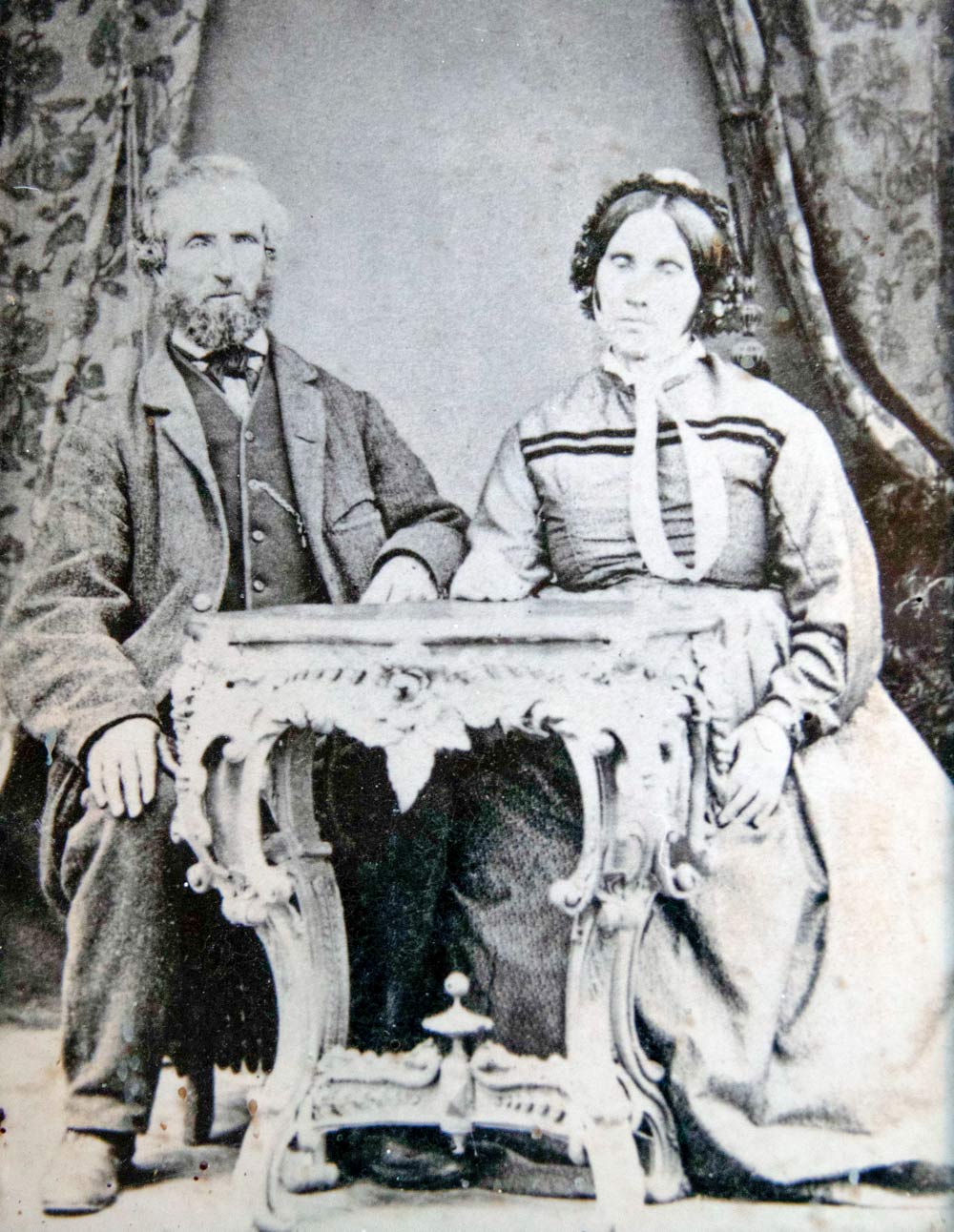
Elizabeth in the 1870s at Lime Kiln, their first home near Green Bay.
